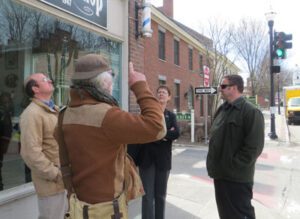One of the most exciting services that we are delivering through the Vermont Digital Economy Project is the installation of Wi-Fi zones and hotspots in communities throughout the state. Our goal is to positively impact 25 towns with this technology, and we have so far successfully installed access points in 20 zones and hotspots.

Tom Marsh, Windsor’s Town Manager, Bob Haight, Windsor’s Downtown Manager, Caro Thompson, Broadband Outreach and Communications Manager at the VTA, and Justin McCoart, of Up and Running Computer Services, discuss Access Point Placement in Windsor, VT.
We are already starting to see the impact of these zones. In Bethel, an average of 163 unique clients use the network each day. Some of those users are school children who received computers as part of the one-to-one program. They now have the whole of the downtown in which to sit and do their school work. In Johnson, the town is already having discussions on the use of the zone on Front Porch Forum, and with an average of 106 unique users per day, it is creating a space for both those who live in Johnson, and those who are just passing through to get online.
As we mentioned last August, our model has been so successful that the Vermont Telecommunications Authority (VTA) has dedicated a portion of its broadband infrastructure funds to help towns create new zones or to expand zones that we have created with our grant. They are doing this as part of their Business Broadband Improvement District Initiative (BBID).
We’re very happy to announce an update on the VTA Wi-Fi project. Four Vermont towns will receive BBID funding for towards Wi-Fi zones. Thanks to this funding, the Tropical Storm Irene-impacted downtowns of Bennington, Waterbury, and Wilmington will expand the zones that we had launched. Additionally, the town of Windsor will get a brand new Wi-Fi zone in its downtown. “The Vermont Digital Economy Project has built a successful model for a citizen-run open and public downtown Wi-Fi zone,” writes Chris Campbell, Executive Director of the VTA, “We are very pleased that we were able to provide funding to expand Wi-Fi zones to include more businesses and more community members.”
The communities themselves are also happy to see their zones expand. For example, in Wilmington, some businesses lie just outside of the current zone. With the expansion, visitors will be able to walk further from town and still stay online. The expansion, therefore, has the potential to help more businesses feel part of a “business district.”
Bennington will also benefit. “Bennington has considered the idea of public Wi-Fi for its downtown in previous years, however the cost has prevent the project from gaining traction,” writes Michael Harrington, Bennington’s Development Director, “Only recently when the Town adopted its economic development plan, and VCRD announced their Digital Economy grant, were we able to see the light at the end of the tunnel. The Digital Economy Grant allowed us to get the project off the ground and the recent collaboration with VTA will ensure that the finished project covers a majority of our downtown business center. We are very pleased with the project and can’t wait for a completely ‘meshed’ network for our community and visitors.”
Over the next few months, The Vermont Digital Economy Project will be working with these four towns in addition to its work in other towns to ensure that these Wi-Fi zones are installed and launched.
“This collaboration is a great opportunity to increase Vermonters’ access to the internet in downtown areas,” said Sharon Combes-Farr, Director of the Vermont Digital Economy Project, “whether it’s increased connectivity for a tourist passing through a downtown, or for a student doing her homework on a laptop, we’re excited to see these zones expand.”
